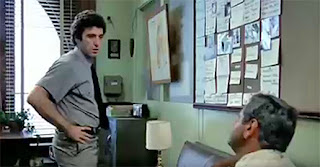Arrow Video, with domestic sales and distribution
support provided by MVD Entertainment Group, has announced a new 4K scan from
the original camera negative (approved and supervised by the filmmaker himself)
of writer/director William Friedkin’s 1980 film adaptation of New York Times
report Gerald Walker’s 1970 novel, Cruising.
The Blu-ray presentation will be available on Aug.
20.
Interest in the book as a film adaptation — a story
about an undercover cop investigating a serial killer of gay men in the Greenwich
Village area of New York City — begin as early as 1971, with industry trade
reports surfacing in 1972 indicating that Paul Morrissey, fresh from the
underground success of Trash
(1970) and Women in Revolt
(1971), had signed on as the director of the project.
Production was to begin in early 1973, with both
Timothy Bottoms and Jeff Bridges (who had both come to prominence after their
1971 performances in The Last Picture Show)
being considered for the role of the undercover detective. However, the project blew up and Morrissey
turned his attention to what would become his cult masterpieces, Flesh for
Frankenstein (1973) and Blood for
Dracula (1974).
 It wasn’t until 1979, when producer Jerry Weintraub
(who had been chalking up annual Emmy Awards nominations for his TV music
specials featuring the likes of John Denver and Neil Diamond) entered the
picture and William Friedkin came onboard as the director, that Cruising was
back in the limelight.
It wasn’t until 1979, when producer Jerry Weintraub
(who had been chalking up annual Emmy Awards nominations for his TV music
specials featuring the likes of John Denver and Neil Diamond) entered the
picture and William Friedkin came onboard as the director, that Cruising was
back in the limelight.
A backstory appeared in the New York Times
indicating that Weintraub had been in contact with the filmmaker over a number
of years to direct the project, but Friedkin was concerned that he didn’t fully
understand the culture. Although he had
adapted Mart Crowley’s gay “cat-fight” play, The Boys
in the Band, back in 1970 (prior to the
success of both The French Connection and The
Exorcist), Cruising was
a very different world. After some
research, Friedkin decided to adapt the book himself … he took the barebones of
Walker’s novel and freely adapted, which he kept secret during the film’s
production.
Filming begin in July of 1979 — with a ten-week New
York City shooting schedule — with Al Pacino in the role of Steve Burns/John
Forbes, the undercover cop assigned to investigate the series of murders. All hell broke loose among the gay community
in New York City (familiar with the book), who did everything possible to
disrupt the filming.
Even after the film was “in the can,” the controversy
continued as the MPAA kept slapping the X-rating on it, which was cut, cut and
re-cut to finally achieve the coveted R-rating. This didn’t satisfy exhibitors who, despite
the R-rating, treated the film, because of its subject matter, as an X-rated
release.
 Friedkin’s adaptation of Cruising turns
out to be part detective-thriller — who is stalking and killing gay men in Greenwich
Village — mixed with the changes that Pacino’s character undergoes (i.e.
“messed up”) while undercover. The
ending, although ambivalent, suggests that while undercover Pacino’s character
may have committed one of the murders.
Friedkin’s adaptation of Cruising turns
out to be part detective-thriller — who is stalking and killing gay men in Greenwich
Village — mixed with the changes that Pacino’s character undergoes (i.e.
“messed up”) while undercover. The
ending, although ambivalent, suggests that while undercover Pacino’s character
may have committed one of the murders.
Bonus features include an archival commentary from
filmmaker William Friedkin and two previously released production featurettes —
“The History of Cruising” and “Exorcizing Cruising.”



No comments:
Post a Comment